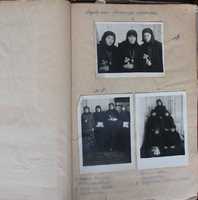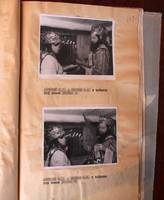Archives of the Information and Security Services of the Republic of Moldova
Item set
Title
Archives of the Information and Security Services of the Republic of Moldova
Arhiva Seviciului de Informații și Securitate al Republicii Moldova
Description
1. History of Foundation
A Special State Repository (SSR) was created within the Intelligence and Security Service of Moldova in 1992 containing the archival collection produced by the former Soviet secret police. This collection is included in the Archival Fond of the Republic Moldova. The collection includes police files created in Moldovan Autonomous Republic of Soviet Ukraine between 1924 and 1940, and in Moldovan Soviet Socialistic Republic from 1940 to 1991. This archive has not been declassified, and limited access to its fonds had been provided only to some historians during different periods after 1991. In 2010 a number of approximately 25.000 police investigation case files have been declassified and transferred to the National Archive of the Republic of Moldova, and since then these files are accessible to researchers and to the wider public.
2. Legal Commission and Task
The Presidential Commission for the Study of the Communist Dictatorship in Moldova was created in January 2010 with the purpose of examining the crimes perpetrated by the Soviet totalitarian regime on the territory of the Republic of Moldova, and for producing a report by June 2010. The transfer of 25.000 police investigation case files to the National Archive of the Republic of Moldova had the additional purpose of providing access to these materials for researchers, the victims of the totalitarian regime, and for the wider public.
3. Material relevant to the Study of Religions
The fond R-3401 of the National Archive of the Republic of Moldova contains exclusively Soviet police investigation case files. Other types of files and documents created by the police of Soviet Moldavia are still not declassified and are preserved in the archive of the Moldovan intelligence service.
The police investigation case files have a specific function and structure. Their main purpose was to prove the alleged guilt of an arrested person by presenting materials and documents produced or collected during the police investigations. The first part of an investigation case file is comprised of official orders and documentation relating to the commencement of the investigation, with data about the arrested person and her or his deeds deemed as criminal. The second part of the file refers to the procedures associated with arresting and searching the victim. An inventory of objects found during the search, fingerprints, mugshots, information about the place, time and circumstances of the arrest were usually added.
Stenographs of interrogation are the most extensive part of the files. They were an important device of incrimination, containing declarations made by the victims under duress, and they translated the deeds and words of the incriminated person into the language of the criminal code. The stenographs are followed by material evidence collected during the searches, that could be attached or included in an envelope. Alternatively, an envelope with confiscated materials can sometimes be found at the end of the file. These kind of materials were comprised of personal documents, letters, photographs, and religious objects (icons, booklets, books, handwritten hymns, etc.).
The stenographs of the trial form a significant part of the documents attached at the end of the file including the decision of a court, and other documents and correspondents created as part of judiciary procedures. The files produced before Stalin’s death in 1953, enclose the correspondence and judiciary decisions regarding the sentence reductions applied during the post-Stalinist thaw. At the very end of the file, a decision of a court of the post-Soviet Republic of Moldova and a number of related documents can also be found. These documents were produced and added to files during the process of rehabilitation of the victims of the Soviet totalitarian regime.
4. Access for Researchers
Researchers can get access to the fond R-3401 by making a request to the director of the National Archive of the Republic of Moldova (Archiva Națională a Republicii Moldova), to which a letter of recommendation from an university or from an institute should be attached.
A Special State Repository (SSR) was created within the Intelligence and Security Service of Moldova in 1992 containing the archival collection produced by the former Soviet secret police. This collection is included in the Archival Fond of the Republic Moldova. The collection includes police files created in Moldovan Autonomous Republic of Soviet Ukraine between 1924 and 1940, and in Moldovan Soviet Socialistic Republic from 1940 to 1991. This archive has not been declassified, and limited access to its fonds had been provided only to some historians during different periods after 1991. In 2010 a number of approximately 25.000 police investigation case files have been declassified and transferred to the National Archive of the Republic of Moldova, and since then these files are accessible to researchers and to the wider public.
2. Legal Commission and Task
The Presidential Commission for the Study of the Communist Dictatorship in Moldova was created in January 2010 with the purpose of examining the crimes perpetrated by the Soviet totalitarian regime on the territory of the Republic of Moldova, and for producing a report by June 2010. The transfer of 25.000 police investigation case files to the National Archive of the Republic of Moldova had the additional purpose of providing access to these materials for researchers, the victims of the totalitarian regime, and for the wider public.
3. Material relevant to the Study of Religions
The fond R-3401 of the National Archive of the Republic of Moldova contains exclusively Soviet police investigation case files. Other types of files and documents created by the police of Soviet Moldavia are still not declassified and are preserved in the archive of the Moldovan intelligence service.
The police investigation case files have a specific function and structure. Their main purpose was to prove the alleged guilt of an arrested person by presenting materials and documents produced or collected during the police investigations. The first part of an investigation case file is comprised of official orders and documentation relating to the commencement of the investigation, with data about the arrested person and her or his deeds deemed as criminal. The second part of the file refers to the procedures associated with arresting and searching the victim. An inventory of objects found during the search, fingerprints, mugshots, information about the place, time and circumstances of the arrest were usually added.
Stenographs of interrogation are the most extensive part of the files. They were an important device of incrimination, containing declarations made by the victims under duress, and they translated the deeds and words of the incriminated person into the language of the criminal code. The stenographs are followed by material evidence collected during the searches, that could be attached or included in an envelope. Alternatively, an envelope with confiscated materials can sometimes be found at the end of the file. These kind of materials were comprised of personal documents, letters, photographs, and religious objects (icons, booklets, books, handwritten hymns, etc.).
The stenographs of the trial form a significant part of the documents attached at the end of the file including the decision of a court, and other documents and correspondents created as part of judiciary procedures. The files produced before Stalin’s death in 1953, enclose the correspondence and judiciary decisions regarding the sentence reductions applied during the post-Stalinist thaw. At the very end of the file, a decision of a court of the post-Soviet Republic of Moldova and a number of related documents can also be found. These documents were produced and added to files during the process of rehabilitation of the victims of the Soviet totalitarian regime.
4. Access for Researchers
Researchers can get access to the fond R-3401 by making a request to the director of the National Archive of the Republic of Moldova (Archiva Națională a Republicii Moldova), to which a letter of recommendation from an university or from an institute should be attached.
Creator
Dumitru Lisnic
Publisher
This project has received funding from the European Research Council (ERC) under the European Union’s Horizon 2020 research and innovation programme No. 677355
Date Created
January 2021
Items
-

Mugshots of Spiritual Fathers from Odaia, Moldova
The mugshot is one of the main visual materials produced by the secret police during their investigations. Together with fingerprints and personal information, mugshots connect the police image of the alleged enemy to an actual person, whom they show stripped of personal dignity and agency, often head-shaven, dejected, pensive and nervous. Mugshots are contained in almost all secret police criminal investigation case files and were produced according to a very precise set of rules which makes them very similar from one case to another. Although at a first glance they seem less interesting than -

Defaced portraits of Soviet leaders Moldova
These mass produced postcard-sized portraits of three soviet leaders, Nikita Khrushchev, Lavrentiy Beria and Anastas Mikoyan, have been torn and inserted into an envelope as evidence in a secret police personal file referring to a collective penal case. They were found during the search of a house of an Inochentist leader on February 11th 1953, a few weeks before Stalin’s death. From the perspective of secret police, the disrespectful attitude towards the abovementioned leaders of those who had torn these pictures equated to an anti-Soviet act. The origin of the defaced images is open to a n -

Confiscated photographs of Archangelist women Moldova
This page from an MGB investigation file from 1947 from Soviet Moldavia shows three images of women preachers from the Archangelist movement, a branch of Inochentism. The first image portrays the women holding crosses in their right hand, facing the camera and cut off at waist height. The composition and symbolism of this image reproduce the visual language of icons. Images of this kind could offend the sensibilities of Orthodox believers. The two lower images carry the same imagery but in a less obvious way. The women are dressed conservatively in dark clothes that are inspired by monastic dr -

Archangelist Staged Ritual Moldova
This photograph which was taken by Soviet secret police officers appears to capture a ritual performed by Archangelists (a branch of the Inochentist movement) in one of their underground chapels. On closer inspection, however, it is evident that this is not a surveillance photograph but rather a staged reenactment performed for the camera. The framing, camera angle, lighting and mood of the photograph were all determined by the secret police photographer with the intention of creating a powerful image for use by the regime. Indeed, the two Archangelists, shown wearing ritual clothing and holdi
